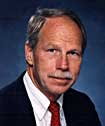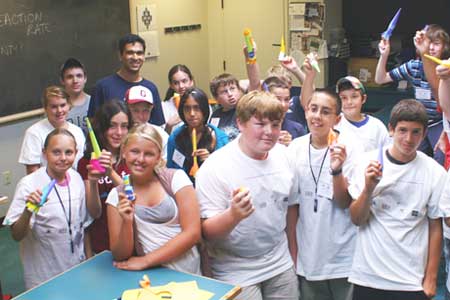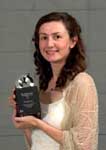
July 2010In this issue: |
|||||
|
1. Liebeck to receive Guggenheim MedalProfessor of the Practice Bob Liebeck will receive one of the most prestigious awards in aviation: the Daniel Guggenheim Medal. The medal recognizes individuals who make profound contributions to advancing aeronautics. Liebeck’s award cites him for “distinguished engineering as evidenced by the conception and development of Liebeck airfoils and blended wing body aircraft.” Liebeck is manager of Boeing’s Blended Wing Body project, a 500-passenger flying wing aircraft. Professor emeritus and former AeroAstro Department Head Earll Murman, who nominated Liebeck for the medal, says, “Bob brings incredible aircraft design experience and wisdom to the classroom, and is always eager to work one-on-one with our students. He’s a wonderful mentor to young people and young faculty. We are really fortunate to have Bob as part of our faculty.” - More on Liebeck and the Guggenheim Medal |
||||
|
2. AA students win NASA competitionsAeroAstro students have recently won first place in two NASA competitions. Students working on the TALARIS planetary hopper vehicle took first place in the NASA-sponsored Revolutionary Aerospace Systems Concepts — Academic Linkage contest designed to help the space agency with new space exploration concepts. The winners included grad students Ben Corbin, Chris Han, Bobby Cohanim, Eph Lanford, Howard Yue, and Phillip Cunio; and undergrads Nana Essilfie-Conduah, Garrett Fritz, and Sarah Vega. Kristen Anderson, Garrett Fritz, Adam Fuhrmann, Jillian James, and Ryan McLinko of Professor Dave Miller's 16.83 Cathode/Anode Satellite Thruster for Orbital Repositioning (CASTOR) class project captured first place in a NASA Space Grant Systems Engineering paper competition. The team received a $3,500 scholarship and an invitation to view a future launch at Kennedy Space Center. |
||||
3 . Pop, fizz - it's Alka-Seltzer aerospaceGrad student Hemant Chaurasia reports that he "had a blast promoting science and engineering to young people" through his "Rocket Science for Middle Schoolers" workshop, held at the Edgerton Center as part of NASA's Summer of Innovation. Under Hemant's guidance, 23 Gloucester middle schoolers designed, built, and launched tiny Alka-Seltzer-fueled rockets, carrying a valuable payload of one M&M candy up towards the International Space Station. (Best comment of the day: "Can I please eat my payload now?") Hemant says, "The workshop involved learning about the contents of the universe, why we need to launch things into space, and the physics of rocketry." He reports that a lot of fun was had by all, and he hopes that some high-flying dreams were among the things successfully launched that day. |
|||||
4. NewsbriefsCongratulations to Professor Brian Wardle for his promotion to Associate Professor with Tenure. Brian is the world leader in developing innovative nano-engineered aerospace composites that provide exciting possibilities for applications in three-dimensional loading situations, and enable tailoring of electrical and thermal properties without degrading material performance. He's also made significant contributions in the area of MEMS-device design, and the identification of new catalysts for carbon nanotube growth.
On May 21, Professor Annalisa Weigel gave birth to 7 lb 8 oz. daughter Teafilia Eve Weigel Walton. Family is doing well. Professor Nick Roy was featured in the MIT News article "3 Questions: Nicholas Roy on Deploying drones in US skies. MIT robotics expert discusses the logistics hurdles of regulating unmanned aircraft for civilian use. Astronauts4Hire has selected AeroAstro Ph.D. candidate Ben Corbin as one of six new commercial astronaut candidates. Astronauts4Hire is a non-profit organization whose mission is to increase the competitiveness of commercial astronaut candidates by providing skills training, facilitating forums for candidate communication, engaging with potential employers, and inspiring the next generation. The first step in Ben's training will be participating in the NASTAR Suborbital Scientist Training Program. Professor Emilio Frazzoli and EECS grad student Sertac Karaman have received Willow Garage's Best Open Source Code Award for their development of RRT(*), which is a software library implementing algorithms introduced in their paper "Incremental Sampling-based Algorithms for Optimal Motion Planning." Professor Oli de Weck has been named recipient of the Capers and Marion McDonald Award for 2010. Established by Capers (M.S. '76) and Marion McDonald, this award is presented to a School of Engineering faculty member who, "through tireless efforts to engage minds, elevate spirits, and stimulate high quality work, has advanced the professional and personal development of students and colleagues." In announcing the award, Dean Subra Suresh wrote, "Oli's commitment to advising and mentoring of MIT students is extraordinary."
Grad student Dan Buckland has received the Society of NASA Flight Surgeons Outstanding Student Award. Dan is involved with the Man Vehicle Lab. NASA has placed a feature article about the Space Systems Lab's Zero Robotics project in its education website. The project involved SSL members and two teams of Idaho high school students, offering the students a chance to work with the lab's SPHERES micro satellites and astronauts on the International Space Station in a competition in which the high-schoolers wrote computer programming code that controlled the basket-ball sized satellites. |
|||||
5. Music for videosOften faculty and students produce wonderful videos of their projects, events, and activities only to find them rejected by the AeroAstro Video Library, TechTV, OpenCourseWare, and other online video collections. The reason: they've enhanced the audio with copyrighted music. If you add Tom Petty's "Learning to Fly" to your Unified Flight Competition video or Roger McGuinn's "Mr. Spaceman" to your water bottle rocket video and you haven't arranged license to do so, you're breaking the law. Copyright law is complicated, but, suffice it to say just because you purchased the recording doesn't give you license to do much more than listen it on your player. And don't think agents for the copyright holders won't come after you — it's happened at MIT more than once. That said, adding music can enhance a video production, and you can obtain tunes that are royalty-free; that is, you can use them freely without violating the law. TechTV has a nice article about this with links to a number of royalty-free music sources. http://scripts.mit.edu/~techtv/blog/?p=21 |
|||||
If you know of events, honors, activities, or other information you'd like to see in the next issue of AeroAstro enews, please send to wlitant@mit.edu — we'd be pleased to include your submissions. |
|||||
© 2010 MIT Department of Aeronautics and Astronautics. All rights reserved. |
|||||




